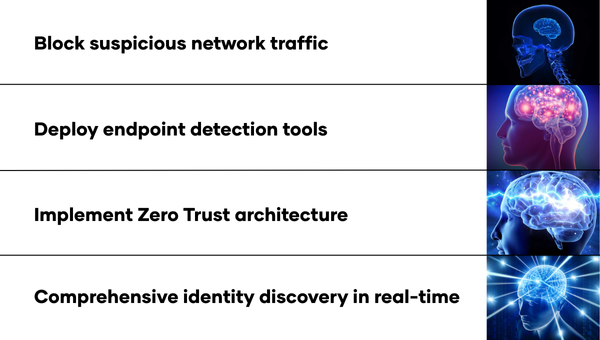Identities are simultaneously the new perimeter and are also the most frequently observed attack vector. Despite significant investments in Identity and Access Management (IAM), Privileged Access Management (PAM), and Identity Governance and Administration (IGA) systems, identity blindspots and security gaps persist. They often lurk around non-human identities, shadow IT accounts, misconfigured cloud entitlements, and fundamental identity hygiene issues—vulnerabilities that are typically exploited long before a SIEM alert is triggered or an EDR agent raises a flag.
So, how do you quantify the return on investing in a proactive approach like Identity Attack Surface Management (IASM)? This blog explores the business case for IASM, confronts the critical truths about the limitations of traditional identity tools, and proposes tangible ways to measure its financial and operational impact.
The Staggering Cost of Invisible Identity Risk
The statistics paint a stark picture:
- The 2025 IBM Threat Intelligence Index found that the average cost of a data breach reached an all-time high of $4.88 million in 2024. “Identity-based attacks make up 30% of total intrusions. For the second year in a row attackers adopted more stealthy and persistent attack methods, with nearly one in three attacks that X-Force observed using valid accounts”
- The 2025 Verizon Data Breach Investigations Report (DBIR) highlighted that Exposure of secrets—such as JSON Web Tokens (JWTs) and cloud API keys—on public repositories like GitHub also played a substantial role, with a median remediation time of 94 days for leaked credentials
- The Change Healthcare Breach in early 2024, impacting a vast portion of the U.S. healthcare system, reportedly began with compromised credentials for a Citrix remote access portal that lacked multi-factor authentication (MFA). This single point of failure underscores the catastrophic potential of an unmanaged identity attack surface. (Widely reported, e.g., TechCrunch, Reuters)
These are not isolated incidents; they are symptomatic of systemic weaknesses in how identities are managed and secured. Yet, many identity teams are still benchmarking their identity security posture against outdated metrics like audit pass rates, the number of access certifications completed, or basic tool deployment coverage. Organizations must rethink this strategy, focusing on feature adoption from these tools, and ensure they are able to have a comprehensive view of all identities that exist within the organization. The real, measurable ROI lies in proactively discovering and shrinking the most pressing identity risks before they materialize as tomorrow’s devastating headline.
Traditional Identity Security: Built for Control, Not Comprehensive Visibility
IAM, IGA, and PAM solutions are indispensable for enforcing policies and managing known identities and discovering previously unknown identities. However, their fundamental design often assumes that the identities they govern are already comprehensively discovered, accurately inventoried, and appropriately managed. This assumption frequently breaks down, leading to:
- Dormant or orphaned accounts: An incomplete understanding of accounts belonging to former employees or unused applications. These accounts linger undiscovered or unmanaged, becoming prime targets.
- Overprivileged users and misconfigured service accounts: Accumulating excessive permissions over time (“privilege creep”) or deployed with default, insecure configurations.
- Shadow identities: Introduced by new projects or software often by developers and other teams who spin up new resources, contractors with temporary access that becomes permanent, or through M&A activities where identity systems aren’t fully integrated or decommissioned. These often exist outside the purview of central IT and IAM tools.
- Toxic combinations of entitlements: Seemingly innocuous permissions that, when combined, can create dangerous privilege escalation paths.
- Credential Compromise: IAM tools leverage siloed hash check comparison methods to determine if a credential has been compromised, rather than comparing public breach dates to last known password change dates across disparate systems
- Legacy System Management: Many IAM and PAM solutions have an inability to integrate with or manage identities attached to legacy on-premises systems or COTS applications. This leaves blind spots and an inability to standardize on identity management controls.
While these existing solutions may ensure adequate controls are applied to manage the credentials, the session, and the lifecycle of the account, they often do not take into consideration other factors which may be important when prioritizing which identity risks are the most important to resolve. Understanding the identities attributes and configuration details, events, and authentication types helps build a more comprehensive view of an identities inherent risks. Security teams might confidently point to dashboards showing 100% compliance for known identities, while a significant portion of the organizations identities remain unmonitored and unmanaged.
The ROI of Proactive IASM: Making the Invisible, Visible and Actionable
Unlike tools that primarily focus on managing the lifecycle of an identity, IASM delivers substantial operational and financial ROI by proactively identifying, prioritizing, remediating, and ultimately reducing real-world attack paths stemming from risks associated with the entire identity fabric.
Here’s how IASM translates into measurable value:
| ROI Area | IASM-Specific Metrics & Actions | Impact & Financial Benefit |
| 🎯 Reduced Breach Risk & Impact | % of high-risk identities (overprivileged, dormant, exposed credentials, shadow IT, misconfigured cloud IAM roles) discovered by IASM and subsequently remediated. | Drastically lowers the likelihood of compromise. Reduces potential for lateral movement and blast radius if a breach occurs. Avoiding even one moderate identity-driven breach can save millions (ref: IBM $4.88M average cost). |
| 🔐 Enhanced PAM & IGA Efficacy | # of previously unknown/unmanaged machine identities, service accounts, SaaS accounts, and risky privileged access paths discovered by IASM and integrated into PAM/IGA. | Maximizes ROI of existing critical (and expensive) IAM investments by ensuring they govern the actual and complete identity landscape, not just a subset. Improves the accuracy and effectiveness of access certifications and PAM controls. |
| ⚙️ Operational Efficiency & Cost Savings | Time saved (e.g., 30-50%) on manual access reviews, security investigations, and audit preparation due to IASM’s automated discovery, correlation, and continuous visibility. | Reduces analyst fatigue, accelerates Mean Time To Respond (MTTR) for identity-related incidents. Frees up skilled security personnel for higher-value strategic initiatives. Potential for significant labor cost savings annually. |
| 🧠 Proactive Threat Prevention & IR Savings | # of suspicious accounts, risky entitlements, potential attack paths (e.g., privilege escalation opportunities) detected and neutralized by IASM before exploitation. | Shifts security posture from reactive (post-breach cleanup) to proactive defense. Significantly cuts down on incident response hours, forensic costs, recovery time, and associated business disruption. |
| 💸 License Optimization & Cost Avoidance | $ saved from identifying and reclaiming unused or redundant software/SaaS licenses tied to dormant, orphaned, or unnecessary accounts discovered by IASM. | Eliminates wasted IT spend, reduces overall operational overhead. Provides clear justification for de-provisioning and optimizing resource allocation. |
A Sample ROI Model You Can Adapt
To build a compelling business case for IASM, consider this adaptable model:
Step 1: Uncover the “Identity Discovery Gap” with IASM
- Premise: IASM solutions typically uncover 15-30% more risky identities (dormant, orphaned, shadow IT, misconfigured service/cloud accounts, excessive permissions) than manual reviews or relying solely on logs from traditional IAM tools.
- Example: For an organization with 50,000 identities, IASM could reveal an additional 7,500 to 15,000 previously unseen or unmanaged accounts and entitlements, many of which could pose a significant risk.
Step 2: Estimate Potential Breach Cost Avoidance
- Context: The 2025 IBM Threat Intelligence Index Report indicates an average breach cost of $4.45 million. Compromised credentials are a leading initial attack vector.
- Calculation:
- Assume IASM helps neutralize even 1% of the newly discovered high-risk identities that could have led to a major breach.
- Potential direct cost avoidance: 1% of $4.45 million = $44,500 per minor incident prevented. For a major incident, this could be the full $4.45M or more.
- Factor in indirect costs: Reputational damage (difficult to quantify but significant), customer churn, regulatory fines (e.g., GDPR can be up to 4% of global annual turnover), increased cyber insurance premiums, and prolonged operational disruption.
Step 3: Calculate Operational Efficiency Gains
- Access Reviews: Reduce time spent per access review campaign by 30-50% due to IASM’s automated data aggregation, risk prioritization, and clear visibility into actual usage.
- Example: If 100 reviewers spend 10 hours each per quarter (4000 hours/year) and IASM saves 40%, that’s 1,600 hours saved. At an average burdened labor cost of $75/hour, this is $120,000 saved annually.
- Audit Preparation: Reduce audit preparation time for identity-related controls by 25-40%.
- Incident Investigation: Reduce time to identify identity-related root causes in security incidents by 50% or more.
Step 4: Factor in Tool Optimization & License Savings
- Existing IAM Stack ROI: By feeding comprehensive identity intelligence into PAM/IGA, their effectiveness (and thus ROI) is significantly boosted. (This is qualitative but important to recognize).
- License Reclamation: If IASM identifies 500 dormant accounts with active SaaS licenses costing an average of $20/month each:
- Savings: 500 accounts * $20/month * 12 months = $120,000 annually.
Example Total Value Estimate (Mid-Sized Enterprise):
- Breach Cost Avoidance (conservative): $100,000 – $500,000+
- Operational Efficiency: $120,000+
- License Savings: $120,000+
- Potential Annual Value: > $340,000 – $740,000 + (plus significant unquantified risk reduction)
Controversial Truth: Compliance ≠ Security, and Many IAM Programs Chase the Wrong Metrics First.
Here’s an uncomfortable truth many CISOs are grappling with: millions are invested in perfecting IAM policies and chasing audit compliance (via use of IGA and PAM tools) based on an incomplete, often dangerously inaccurate, picture of the actual identity landscape. Traditional IAM often starts with the question: “Who should have access to what?” IASM forces the critical precedent question: “Who actually has access to what, how did they get it, what are they doing with it, and what is the associated risk for every identity?“
Without this foundational, continuously updated visibility – no IAM stack can be truly secure. Compliance reports, in this scenario, can offer a dangerously false sense of security, ticking boxes while true risks still proliferate.
IASM flips the paradigm: Comprehensive visibility and risk understanding first, then targeted, effective policy enforcement and adaptive governance second.
Recommendations for Realizing IASM ROI
To begin unlocking the tangible benefits of IASM, organizations should:
- Implement Continuous, Automated Discovery: Move beyond periodic, manual reviews or point-in-time scans. Implement solutions that offer always-on discovery of all identity types (human, machine, federated, local) across all environments (on-prem, multi-cloud, SaaS).
- Map the Entire Identity Fabric: Go beyond simple lists of users. Correlate identities with their entitlements, activities, and relationships to resources and other identities to understand the true “blast radius” and potential attack paths.
- Prioritize by Real, Calculated Risk: Implement dynamic risk scoring for identities based on actual exposure (e.g., public-facing, involved in past incidents), privilege level, entitlement hygiene (e.g., dormant, over-permissive), and observed behavior. Focus remediation efforts where they matter most.
- Integrate for Action & Automation: Feed the rich intelligence from IASM into your existing security ecosystem:
- IGA/IAM: For more informed access certifications and policy enforcement.
- PAM: To discover unmanaged privileged accounts and ensure comprehensive vaulting.
- SIEM/SOAR: To enrich alerts with identity context and automate response actions (e.g., disable risky account, trigger step-up MFA).
- Track and Report on IASM-Specific KPIs: Demonstrate value with metrics like: “Newly Discovered High-Risk Identities per Week,” “Dormant Accounts Decommissioned,” “% Reduction in Standing Privileges,” “Time-to-Detect New Shadow Cloud Identities,” “Reduction in Mean-Time-to-Remediate Risky Entitlements.”
Conclusion
The identity attack surface is vast, dynamic, and growing faster than most security teams can manually track. Proactive Identity Attack Surface Management doesn’t just help you see the problem; it provides the critical intelligence to measure it, manage it, and measurably reduce associated risks.
When you can clearly articulate to your CISO or board how IASM helped eliminate thousands of high-risk accounts, prevented potential breaches by closing unseen attack paths, or cut incident response time for identity threats by a significant margin, the return on investment becomes not just quantifiable, but indisputable. It’s about transforming identity security from a perceived cost center into a strategic enabler of business resilience and trust.




